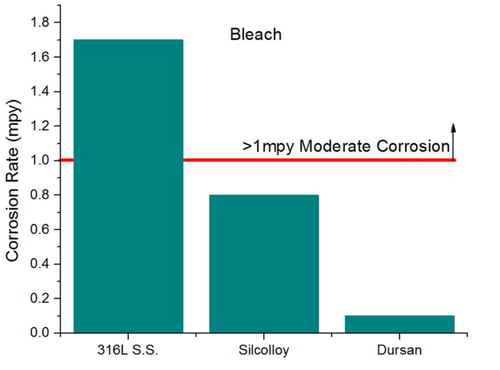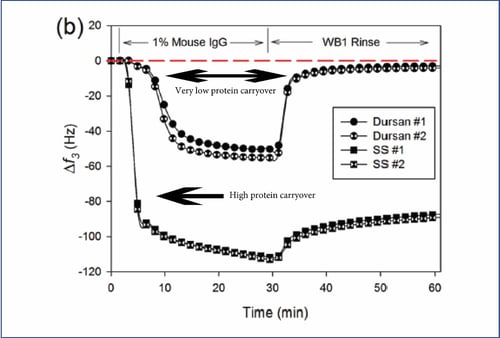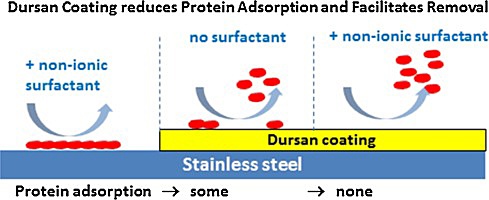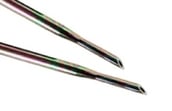How to make the flow path and fritted filters corrosion resistant?
Stainless steel flow path components like sintered metal frits, needles, tubing, fittings, valves, and pumps are durable but can corrode. Corrosion can lead to system failures, contamination, and carryover. To prevent corrosion, you can either change the material or change the surface. A material change can be expensive, require component redesign or open the Pandora's box of unintended consequences. That's why corrosion resistant coatings make sense for improving fritted filter corrosion resistance.
Corrosion resistant coating.
A pitted surface can impact analyte flow, hide trace contaminants and result in excessive maintenance or system failures. A corroded filter can contaminate the HPLC flow path even though the filter is a relatively small component. That's because the surface area is immense. Compounding the problem, filters have notoriously small passages.
Can a fritted filter or a needle be coated? Yes, a silicon coating applied by chemical vapor deposition (CVD) like Dursan's corrosion resistant surface prevent interaction with stainless steel surfaces and can penetrate filter surfaces down to a few microns.
How corrosion resistant is Dursan? Dursan® can Improve corrosion resistance by an order of magnitude for a variety of corrosives, including bleach.

Comparative ASTM bleach immersion studies show Dursan prevents surface attack by preventing interaction of corrosive analytes or cleaning agents with the surface; outperforming other coatings or stainless steel surfaces by an order of magnitude.

What about bioinertness? Can Dursan prevent carryover?
Yes, Dursan® prevents protein binding, corrosion and fouling in HPLC sampling systems. A recent study by Abbott Laboratories in Applied Surface Science demonstrates the inertness performance and corrosion resistance of Dursan. Comparative QCMD (quartz crystal microbalance with dissipation monitoring) characterization of the Dursan coating shows significant reduction in protein surface retention. Preventing carryover and potential false positive test results. The graph below shows the Dursan surface (top line) returns to baseline weight after contact with the test protein analyte. The bottom line shows the stainless steel surface retaining the protein sample and not returning to baseline weight; indicating retention of protein. Read the entire paper.
Improve the bioinertness of your HPLC sample system.
Read the Abbott Laboratories paper.

Can Dursan® Prevent fouling?
Preventing buildup or fouling in flow paths will improve test accuracy and system flow performance. Dursan facilitates surfactant rinse performance; eliminating the potential of contaminant buildup. Benefits of an anti-fouling surface include:
- Proteins, blood, and bio-molecules should not stick to the coated surface.
- A non-stick surface will improve analytical sensitivity and reliability
- Increase device/instrument up time and overall efficiency.
- Allow for easy and complete rinsing with a non-ionic surfactant.

Coat places most coatings can't reach.
 It's hard to find a coating that can improve performance and work within HPLC system tolerance and architecture. But silicon CVD coatings can do the job. That means being able to coat flow path needles, tubing, fittings and precision components without changing the flow, function, or capability. Benefits of precision coatings include:
It's hard to find a coating that can improve performance and work within HPLC system tolerance and architecture. But silicon CVD coatings can do the job. That means being able to coat flow path needles, tubing, fittings and precision components without changing the flow, function, or capability. Benefits of precision coatings include:
♦ Able to coat the interior and exterior of narrow bore needles, narrow tubing, complex component designs, etc. Customers now have the ability to improve inertness and protect the entire sample flow path.
♦ A high tolerance coating that does not significantly change part dimensions or tolerances. That means the user can coat existing components and significantly improve performance without part redesign.
Coating Durability
HPLC compatible surfaces must be durable. The surface must survive hundreds of injections, abrasion, and surface wear. Coatings must not flake or fail when the surface is flexed or suffers an impact. Watch our durability video and see for yourself.
Coating applications for optimizing bio separation.
Typical applications for high durability inert coatings in bioinert applications include:
- Clinical chemistry and immunoassay analyzers
- Precision stainless steel tubing
- Mandrels, plungers, extrusion tips, dies
- Chemical vessels/containers
- Wires, wire coils, wire forms
|
- Guide wires
- Curettes
- Cannulas
- Screws, prostheses, plates
- Needles
|
- Syringes
- Sensor probes
- Catheters
- Knives, surgical tools, lab surfaces
|
Dursan® offers three critical surface properties in one along with a chemical vapor deposition (CVD) coating process that makes application easy and effective even on complex geometry components.
Learn more about bioinert coatings. Download our coatings guide.









